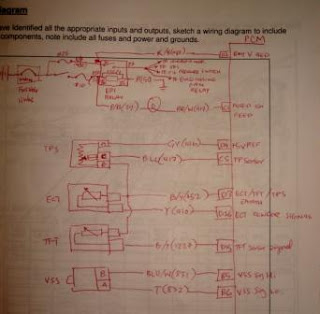The name of the relay or the switch that powers up the ABS ECUK39
The name of the relay or switch that powers up the ABS pumpK100
The name of the relay or switch that sends power to the ABS HCU solenoidsK38
Relay wire identification:The ECU pin number for the wire that brings in the power to the ABS ECU
1
The ECU pin number or other numbers for the wire that controls the relay for the ABS ECU
28
The pin number for the wire that brings in the power to the ABS pump
14
The pin number for the wire that controls the relay for the ABS pump
28
Capture a waveform that shows both the control circuit change when it turns on the relay, and the power swithcing on to power something in the ABS system.Relay waveform: Channel 1 is the switching circuit & Channel 2 is the control circuit.

1. The switching channel is at 12v.
2. The switching channel is grounded however the control circuit voltage doesnt increase. Possibly there was an interference in the switching signal which explains why voltage in the control circuit doesnt increase, but only slightly oscillates at the 0v mark.
3. Finally the relay works. The switching voltage is grounded, and voltage is flowing through to the control circuit as it shows in channel 2 the voltage is now at 12v.
4. The switch is off, and channel 1 is no longer grounded and returns to 12v. The control circuit is off and returns to 0v.
ABS Pump Relay Waveform:Channel 1 is the switching circuit & Channel 2 is the control circuit.

1. Nothing is operating at this point. Voltages are 0v.
2. Switch is activated and the switching circuit reading goes up to 12v.
3. The relay begins to operate. The switching circuit voltage is grounded and the voltage on the control circuit increases to 12v.
4. The relay is shut off, and now the switching channel is no longer grounded.
5.The relay closes suddenly and induces these small oscillations of back EMF.
6. The switching circuit is off, and pulls to ground. This induces a voltage spike in the control circuit before it oscillates back to ground (unseen).
Discuss what is happening during the ABS self test.When you first turn on the key, the ABS commences the self test to check
if all the ABS

braking components are functioning and responding correctly.So once the key is turned, the ABS light comes on and current activates the ABS pump relay. The self check is in operation, and if anything has a fault, the ABS module wouldn't ground the fail-safe relay and warning light would stay on. Which would indicate to the driver there was something wrong.
Create a fault in the system by slowing down a WSS or safely shorting out an inductive WSS while you are applying the brakes (Don't short out a Hall Effect or Magneto-Resistive sensor). As you are applying the brakes, notice if the ABS pumps turns on, solenoids turn on, or if the hydraulic pressure changes in one of the brake circuits and shows up on the pressure gauge. To manually slow down a single WSS, we used a plastic pipe
to press against the ring gear.

While pressing on the brake, we slowed down the WSS by pressing the plastic pipe against the WSS.
This makes the ABS control module think that this wheel is beginning to lock up. To prevent lockup the ABS system activates a solenoid that closes the inlet valve and open the outlet valve to stop excess brake pressure being applied to that wheel. By doing this, the wheel is not locked up and you maintain stability and steerability.
Catch an oscilloscope pattern when an ABS solenoid has actuated. What is the pin name of the solenoid? and how did you do it?

This graph on the right identifies the pins:
LF = 1B
RF = 1C
RL = 1D
RR = 1A

On the left is the oscilloscope pattern captured from 1A (RR).
We connected the oscilloscope to the solenoid wire in the control module guided by the circuit diagram and grounded it. We operated the ABS modulator and pressed the brakes. We used the plastic pipe to manually slow down the WSS connected to this solenoid. This pattern was the reading.

 Wire Colour: Yellow/Brown
Wire Colour: Yellow/Brown Wire colour: Yellow/black
Wire colour: Yellow/black






















